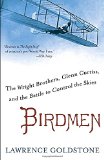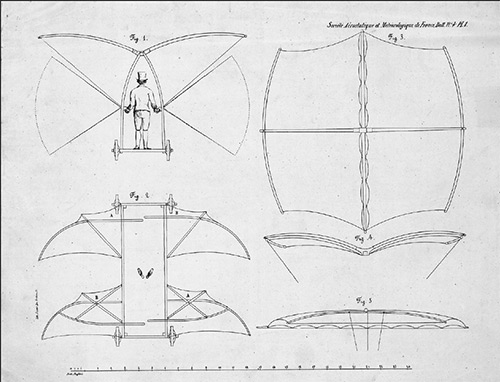Summary | Excerpt | Reviews | Beyond the Book | Readalikes | Genres & Themes | Author Bio
The Wright Brothers, Glenn Curtiss, and the Battle to Control the Skies

Critics' Opinion:
Readers' Opinion:
First Published:
May 2014, 448 pages
Paperback:
Apr 2015, 448 pages
 Book Reviewed by:
Book Reviewed by:
Poornima Apte
Buy This Book
Aerodynamics as a separate science was born in 1799 when an English polymath named George Cayley produced a remarkable silver medallion. Cayley had observed that seagulls soared for great distances without flapping their wings and therefore hypothesized aircraft wings as fixed rather than movable. On the front side of his medallion, Cayley etched a monoplane glider with a cambered (curved) wing, a cruciform tail for stability, a single-seat gondola, and pedals, which he called "propellers," to power the device in flight. On the obverse side of his medallion, Cayley placed a diagram of the four forces that figure in flight: lift, drag, gravity, and thrust. Although actual powered flight was a century away, Cayley's construct was the breakthrough that set the process in motion. In 1853, four years before his death, a fixed-wing glider of Cayley's design was the first to carry a human passenger.
Cayley's hypotheses did not immediately take root. Not until the 1860s did his work finally spark a rush of interest. The Aeronautical Society of Great Britain was formed in 1866; another was begun in France three years later. Discussions of materials, airfoils, and resistance began to drift across borders and disciplines. Theorizing grew in sophistication and began to take in angle of incidence, the angle at which an airfoil moves through the oncoming air, now called "angle of attack"; and center of pressure, the point on a surface where the pressure is assumed to be concentrated, just as center of gravity is the point at which the entire mass of a body is assumed to be concentrated.

George Cayley's design drawing of a man-powered flying machine.
As the body of aerodynamic knowledge expanded, serious experimentation grew along with it. By the time Lilienthal strapped on his first set of wings, movement toward human flight seemed to be nearing the inexorable. But if the process was to move forward with any efficiency, experimenters would need some means to separate what seemed to work from what seemed not to—data and results would have to be shared. The man who most appreciated that need was someone who, while not producing a single design that resulted in flight, was arguably the most important person to participate in its gestation.
Octave Chanute was born in Paris on February 18, 1832. His father was a professor of history at the Royal College of France but in 1838 crossed the Atlantic to become vice president of Jefferson College in Louisiana. The elder Chanut—Octave later added the e to prevent mispronunciation—moved in 1844 to New York City, where Octave attended secondary school, and, as he put it, "became thoroughly Americanized."
Upon graduation, he decided to study engineering. As there were only four dedicated colleges of engineering in the United States, most aspirants learned on the job, as Chanute chose to do. In 1849, he asked for a job on the Hudson River Railroad at Sing Sing and, when told nothing was available, signed on without pay as a chainman. Two months later, he was put on the payroll at $1.12 per day and four years after that, completely self-taught, was named division engineer at Albany. But with immigrants pouring into Illinois to buy government lands at $1.25 per acre, Chanute instead went west. He gained high repute on a number of railroad assignments and eventually submitted a design for the Chicago stockyards that was chosen over dozens of others. With the successful completion of that project, Chanute was asked to attempt a traverse of the "unbridgeable" Missouri River. Chanute's Hannibal Bridge at Kansas City not only successfully spanned the waterway but elevated the city into a center of commerce, and its designer to national acclaim.
Excerpted from Birdmen by Lawrence Goldstone. Copyright © 2014 by Lawrence Goldstone. Excerpted by permission of Ballantine Books. All rights reserved. No part of this excerpt may be reproduced or reprinted without permission in writing from the publisher.




People who bite the hand that feeds them usually lick the boot that kicks them
Click Here to find out who said this, as well as discovering other famous literary quotes!
Your guide toexceptional books
BookBrowse seeks out and recommends the best in contemporary fiction and nonfiction—books that not only engage and entertain but also deepen our understanding of ourselves and the world around us.